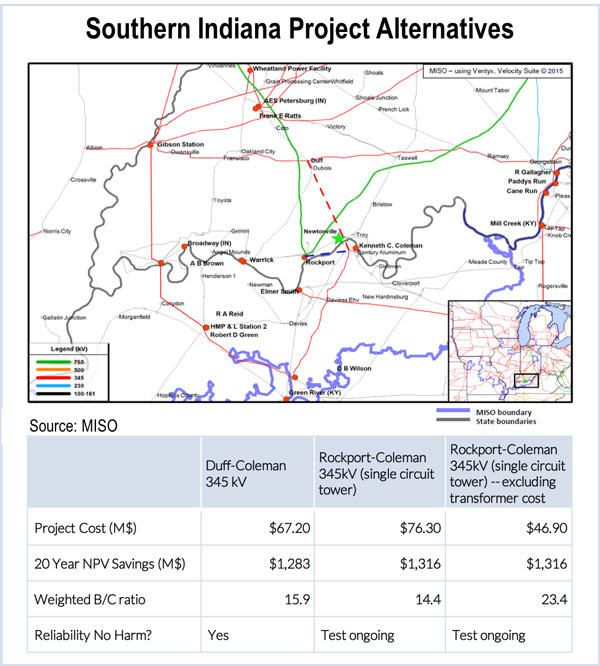KANSAS CITY — SPP’s Board of Directors/Members Committee last week voted to approve moving the deadline for day-ahead market offers up 90 minutes to 9:30 a.m. CT following continued debate over costs and tradeoffs.
The Members Committee approved the motion 8-5, with six abstentions. The board vote is not public, but Chairman Jim Eckelberger took the somewhat unusual step of ensuring that the board and Members Committee quickly knew the motion had passed.
The measure passed the Markets and Operations Policy Committee and other stakeholder groups with similar splits. Some members questioned the expense and effort to implement a small change. Members from SPP’s northern footprint have complained that the adjustments do little to increase the knowledge of day-ahead prices. (See SPP Members Reluctantly OK Day-Ahead Change.)
The change is intended to comply with the Federal Energy Regulatory Commission’s Order 809, which moved the timely nomination cycle deadline for gas to 1 p.m. CT from 11:30 a.m. and added a third intraday nomination cycle.
Assuming FERC approval, SPP will post day-ahead results at 2 p.m. CT, up from 4 p.m. It also shortens the reoffer period to 45 minutes, with reliability unit commitment (RUC) offers due at 2:45 and results posted by 5:15.
SPP faces an Aug. 4 compliance filing deadline with FERC. “If we don’t pass this, we will have to say why we can’t comply,” Carl Monroe, SPP’s chief operating officer, said before the votes. “And I’m not sure I can defend that.”
SPP staff has estimated it will take $1.5 million and 14 months to implement the changes, which will require new software. Staff suggested including that work with the Enhanced Combined Cycle (ECC) project.
Bruce Rew, SPP’s vice president of operations, noted that both projects improve the market-clearing engine’s functionality. “We would be working both together in the same project, because both are focused on improving solution time,” Rew said.
Board Backs Change to ARR Allocations
The board also approved the MOPC’s recommendation to change the annual auction revenue rights allocation system capacity to better match the annual transmission congestion rights (TCR) auction and reduce underfunding.
The board agreed with the MOPC’s recommendation to change the percentage for ARR allocation from the original 60% of system capacity to 80% for the seasonal or shoulder months. The percentages are unchanged for June (100%) and July to September (90%).
Those pushing the 60% allocation for seasonal months said it was an aggressive number and would solve the TCR markets’ underfunding problem, but they recognized it would cause problems for some market participants.
“I think the members said at MOPC that by going down to 60%, you are masking all the other issues,” Xcel Energy’s Bill Grant said.
The revision will settle or convert all annual ARRs during the annual process. No ARRs would be carried forward, and infeasible TCRs would be reduced. All residual capacity would still be allocated and auctioned in monthly processes.
Out-of-Bandwidth Projects Ordered Re-Evaluated
Continuing a discussion that began at the MOPC meeting two weeks earlier, the board put seven over-budget transmission projects on hold, ordering them to be brought back to the board in January following “proper evaluations.”
The seven projects were initially estimated by a third-party consultant to cost $62.8 million as part of the 2015 Integrated Transmission Planning 10-Year Assessment (ITP10). After the projects’ notices to construct (NTCs) were issued, additional study by the members revealed the projects’ cost would come to $147.7 million. (See SPP Frustrated over Transmission Project Overruns.)
The projects were among those filtered out of the 30 committed projects resulting from the ITP10 and near-term planning processes. Only four projects came within a 30% variance “bandwidth,” with 23 exceeding that threshold and three projects coming in below.
SPP staff brought seven of the largest above-estimate projects to MOPC, which recommended suspending NTCs for three of the projects and moving forward with the other four.
But the board overruled MOPC in ordering all seven restudied. NTCs are decisions for the board, Director Julian Brix said.
“The board giveth, the board taketh away,” he said. “There’s too much differentiation in these projects. This is about the board’s fiduciary responsibility.”
SPP Vice President of Engineering Lanny Nickell said his staff conducted interviews with the transmission owners granted NTCs. The feedback indicated material and labor costs were similar, but the third-party consultant had not taken into account individual design standards, rebuilding aging facilities, unforeseen substation work or building through wetlands or other sensitive areas.
“We didn’t ask the right questions,” Nickell said. “We didn’t have adequate information during the planning process.”
Nickell said transferring study responsibility to the third party, a compressed timeline and dealing with competitive information also contributed to the variances.
“The third party did a horrible job,” said Kelly Harrison, president of Westar Energy’s Prairie Wind Transmission. “All they had to do was ask. There wasn’t anything about the project that … we wouldn’t have shared with them.”
SPP was able to allay the concerns of American Electric Power and others that the re-evaluations would change the projects’ reliability or economic needs, and with it, cost allocations. Stuart Solomon, president of AEP’s Public Service Co. of Oklahoma, noted AEP is responsible for four of the seven projects, “all reliability rebuilds based on need.”
“I don’t feel the existence of the variance is a reason to suspend and re-study,” Solomon said during the discussion. He eventually supported the board’s decision, with the hopes SPP could “strive” for the October MOPC and board meetings.
Nickell said staff would be able to meet the board’s timeline, using detailed project proposals already in hand. AEP’s Linwood-South Shreveport 138-kV line rebuild has a 2017 need date, but Nickell said a mitigation plan is in place, should there be further delays.
No Raise in Administrative Fee Expected
Finance Committee Chairman Harry Skilton said the RTO expects its administrative fee for 2016 to be between 37 cents/MWh and 38 cents/MWh, consistent with the 2015 budget’s forecast.
The fee is currently 38.1 cents/MWh, having jumped about 15 cents since 2011 to pay for the Integrated Marketplace.
Skilton noted several factors that could affect the fee: 2015’s monthly peak loads, which are running 5% below 2014’s; the costs of complying with version 5 of the Critical Infrastructure Protection reliability standard; and the costs of improving combined-cycle functionality.
Date Change for Walkemeyer Project RFP
The board approved a staff recommendation to change a key date in its first competitive solicitation under Order 1000, the Walkemeyer-North Liberal project in Kansas.
General Counsel Paul Suskie said the change “mitigates a flaw in the process” by moving the “regulatory approval need date” eight months from the NTC’s issuance.
The SPP Tariff requires the need date be included in a competitive upgrade’s request for proposals to identify when an entity must have gained utility status in the state where the facility will be built. The change would meet a Kansas Corporation Commission statutory obligation to rule on such requests within 180 days of the initial filing and give the winning entity “reasonable time” to gain utility status in the state.
The board approved the 21-mile, 115-kV Walkemeyer project in April. The RFP was issued in May, with responses due Nov. 2. (See SPP Issues RFP for 115-kV Transmission Project.)
The original regulatory approval date was June 1, 2016. The board approval moves that date to Jan. 1, 2017. Changing the date gives RFP respondents sufficient time to finalize their work, Suskie said.
Suskie said staff would work with the Competitive Transmission Process Task Force to develop new policy setting to ensure future RFPs include a date that is reasonable and allows for the SPP process to work as designed.
New Member Process, Document Approved
The board approved a Strategic Planning Committee task force’s recommendations on improving the process of wooing prospective members to join the RTO.
The board first added several modifications to those offered the previous day by the Regional State Committee to a document outlining triggering mechanisms for when communication and work-group processes to be followed during negotiations with prospective members would apply.
The task force report notes that SPP’s staff “remains solely responsible for the direct negotiations with the prospective member” while stakeholders provide input on policy and changes to the governing documents.
SPP Seeks Larger Board
CEO Nick Brown said SPP has filed with FERC modifications to the bylaws that would allow up to three additional directors. He said the Corporate Governance Committee will be evaluating the results of an RFP to conduct a search for board candidates, the first such search SPP has conducted in seven years. The committee will discuss the issue further during its Aug. 27 meeting.
Competitive Tx Task Force Extended
The board approved extending the Competitive Transmission Process Task Force’s charter through 2016 and endorsed the group’s Load Responsible Entity concept. Golden Spread Electric Cooperative’s Mike Wise, chair of the Strategic Planning Committee, said the task force intends to bring a “full package” of recommended improvements to the MOPC in January. (See “Load Responsibility White Paper” in SPP Strategic Planning Committee Briefs, July 20.)
Two New Members
SPP welcomed its two newest members during the meeting: the Tri-State Generation and Transmission Association and Harlan Municipal Utilities. The additions increase SPP’s membership ranks to 92.
Tri-State Generation is a wholesale electric power supplier owned by the 44 electric cooperatives that it serves. The association generates and transmits electricity to its member systems throughout a 200,000-square-mile service territory across Colorado, Nebraska, New Mexico and Wyoming.
Harlan provides electricity, gas, water and telecommunications to a city of more than 5,100 in southwestern Iowa.
Special Guest
FERC Commissioner Cheryl LaFleur was among those sitting in the board’s inner circle. “I’m here to listen,” said LaFleur, who was in the area for Clean Power Plan-related hearings.
— Tom Kleckner
















